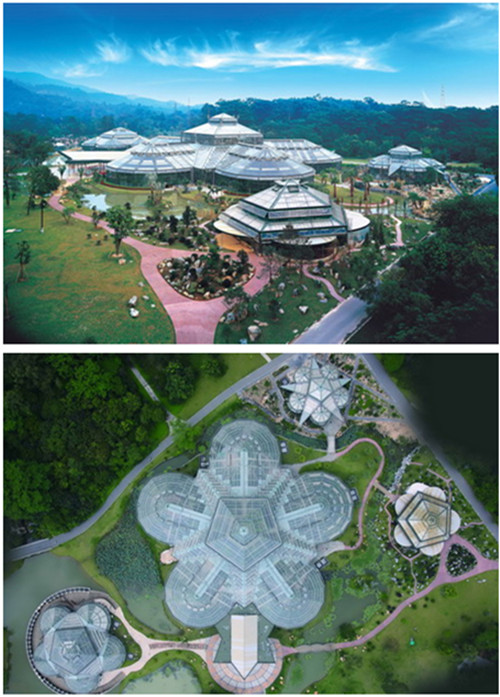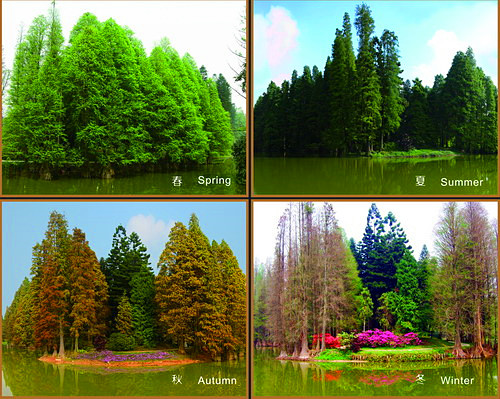South China Botanical Garden (SCBG), Chinese Academy of Sciences (CAS) is one of the oldest botany research institutions in China. SCBG, formerly known as the Institute of Agriculture and Forestry, Sun Yat-Sen University, was founded in 1929 by renowned botanist academician Chun Woon-Young, and was renamed South China Institute of Botany, CAS in 1954. The South China Institute of Botany established the South China Botanical Garden and China's first national nature reserve--the Dinghushan Nature Reserve in 1956, and was renamed to its current name in October 2003.
Since 2018, SCBG has achieved the overall goal of "Taking the Lead in Action Plan", which includes wholly entering into the core botanical garden feature institute, partly entering into the South China Sea Ecological and Environmental Engineering Innovation Research Institute, the Seed Innovation Research Institute and the Pharmaceutical Innovation Research Institute.

As the largest comprehensive garden and one of the top plant germplasm conservation institutions in China, SCBG consists of three divisions:
1) A nursery and exhibition zone, viz. the arboretum, occupying an area of 282 ha, which was designed mainly for plant ex-situ conservation with more than 17,560 plant taxa growing in 38 special living collections, including magnolias, bamboos, palms, gingers, orchids, medicinal plants, etc. It also builds with modern exhibition greenhouse and science popularization center.
2) A research and residential zone, covering an area of 37 ha. It contains 4 research centers including Plant Science Center, Ecology & Environmental Sciences Center, Agriculture & Resource Plant Center and Molecular Analysis and Genetic Improvement Center, several support departments such as a herbarium with more than 1,100,000 plant specimens being conserved, a library, the editorial office ofJournal of Tropical and Subtropical Botany, a computer network center and a public laboratory with CMA and CNAS dual qualification certification.
3) Dinghushan National Nature Reserve, established in 1956,is the first national nature reserve in China and the only reserve affiliated to CAS. Over 2,291 plant species are in situ conserved in an area of 1,155ha.
In addition, SCBG runs 3 field research stations, including Dinghushan National Field Research Station of Forest Ecosystem, Heshan National Field Research Station of Forest Ecosystem, and Xiaoliang Research Station for Tropical Coastal Ecosystem; 3 key laboratories of CAS, namely, Key Laboratory of Plant Resources Conservation and Sustainable Utilization, Key Laboratory of Vegetation Restoration and Management of Degraded Ecosystems, Key Laboratory of South China Agricultural Plant Molecular Analysis and Genetic Improvement; 2 key laboratories of Guangdong Province, namely, Key Laboratory of Guangdong Digital Botanical Garden, Key Laboratory of Applied Botany of Guangdong Province; and several research platforms such as Development Engineering Technology Research Center of Characteristics Plant Resources of Guangdong Province, Guangdong Germplasm Bank, South China Plant Identification Center.
At the same time, SCBG runs Botanic Gardens Conservation International (BGCI) China Program Office, Secretariat of International Association of Botanic Gardens (IABG). It is also the affiliated unit of Botany Society, Plant Physiology Society and Ecology Society of Guangdong Province.
Since affiliated to CAS in 1954, in total 433 monographs such as Flora of China, The Vegetation of Guangdong, Studies on the Tropical and Subtropical Degraded Ecosystem and Its Rehabilitation, Rare Plants of China, and Introduction to Restoration Ecology have been compiled and published by SCBG.
Until the end of 2018, over 3,420 scientific papers have been published in internationally peer-reviewed journals including highly prestigious journals such as Nature and Science; research achievements have been awarded prizes for 305 times at various levels and were twice honored as "Top Ten Basic Research News in China" in 2000 and 2006, respectively. In total 483 patents have been filed, of which 260 have been licensed. In addition, 143 new plant varieties have been validated or registered internationally since 1988.
In the past decades, SCBG has established several extensive and productive exchange and collaboration programs with research institutions in dozens of countries, hosting more than 150 international visiting scholars each year. SCBG has successfully organized 19 international conferences since 2002, including Workshop on Biodiversity Conservation & Management, International Annonaceae Workshop, International Workshop on Plant Reproductive Biology, Symposium on Theory of Ecosystem Succession and Practice of Ecological Restoration, 13th Conference of International Association of Botanical Gardens, 23rd New Phytologist Symposium: Carbon Cycling in Tropical Ecosystems, Third International Conference on Vetiver, Second International Symposium on Family Magnoliaceae, International Symposium on Artemisia and its Allies and etc..
By the end of 2018, SCBG has 452 staff members , including 363 professional researchers (60 professors and 88 associate professors).

SCBG is one of the first batch of postgraduate education units approved by Academic Degrees Committee of the State Council. It has 4 authorized doctor degree disciplines (botany, biochemistry & molecular biology, genetics and ecology), 7 authorized master degree disciplines (botany, biochemistry & molecular biology, genetics, ecology, ornamental plants & horticulture, wildlife conservation & utilization, biotechnology engineering), 2 postdoctoral research station of first-level disciplines (biology, ecology). There are 422 enrolled graduate students.
As a National 4A Tourist Attraction, SCBG receives about 2 million visitors per year. SCBG has paid great attention to knowledge dissemination and science popularization education, held various kinds of popular science training and large-scale popular science activities throughout the year. SCBG is a National Popular Science Education Base, the Most Popular Base for Popular Science in Guangzhou, and a Patriotic Education Base.
In tune to national strategic objectives and the frontiers of sciences, SCBG will continue to devote to plant protection in the same latitude region, scientific research and knowledge dissemination,and carry on fundamental, strategic and cutting-edge basic research projects in botany, ecology, plant resource conservation and sustainable utilization,aim to become a high-level research institution and built a world-class botanical garden in five years.
